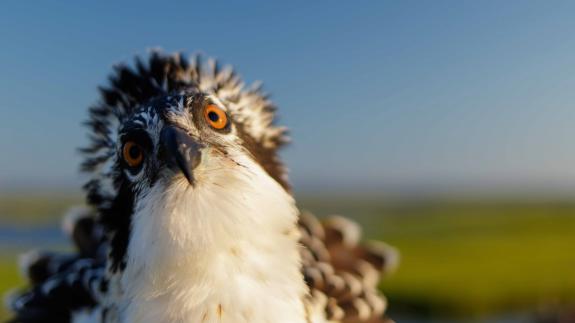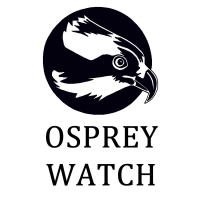Osprey Cam FAQ
Here are some "Frequently Asked Questions" to accompany our Osprey Cam.
 A six week old osprey looks up as another bird catches its eye above its nest. Ben Wurst
A six week old osprey looks up as another bird catches its eye above its nest. Ben Wurst
What is an osprey?
An osprey (Pandion haliaetus carolinensis) is a large bird of prey, which is sometimes referred to as a “fish hawk.” They are found in open areas and nest near water, where they find their main food source, fish. In New Jersey most ospreys nest along the Atlantic Coast from Sandy Hook to Cape May and then west along the D. Bayshore to Salem with less frequent nests along the D. River and in N. Jersey.
What’s the current status of ospreys in New Jersey?
Currently ospreys are listed as a threatened during the breeding season, which starts in April and lasts until the end of August. During the last state-wide census (in 2017) a total of 668 nesting pairs were found using sightings from volunteers and "Osprey Watchers" throughout the state. Overall ospreys are doing well with a modest growth rate of around 10% per year over the past decade. The next census won't occur until 2021, but anyone interested in reporting activity at nests can do so online via Osprey Watch.
Ospreys mate for life and return to the same nest site, year after year.
What do ospreys eat?
Ospreys feed primarily on fish which consists of 99% of their diet. They are an opportunistic apex predator and will feed on almost any (live) fish they can successfully catch. Their diet changes throughout their range and the year. In spring they feed more heavily on spawning fish like mullet, shad, river herring, menhaden and striped bass and in summer feed more on flounder and menhaden or bunker, which are staples for adults to catch and feed their young. They could be called a “specialized generalist” and are not picky eaters!
When do they arrive and depart? Where do they winter.
Ospreys typically arrive back from their wintering grounds in N. South Americain mid-late March. Generally, older more experienced males arrive first and return to the same nest site year after year. Females follow the males and young adults return later in the season and in some cases do not breed but form a pair bond with a female and establish a nest site. The following year (if they survive migration and the winter) then they’ll return and raise young.
During fall migration females leave first - in August - then the males and juveniles follow. Some believe that females leave first to ensure safe passage to their wintering areas (which they also return to the same area, year after year) before more tropical storms threaten their journey. Migration peaks during the first week of October in Cape May. Cape May Point State Park is a great place to visit during this time of year to witness the fall migration of many birds of prey.
For more information on osprey migration, check out some of the work by Rob Bierregaard, who has been studying osprey migration in the Western Hemisphere.
The majority of ospreys that are from New Jersey winter in N. South America. We've gotten band resightings from Florida, Cuba, Dominican Republic, Caymen Islands, St. Croix, Grenada, Costa Rica, Colombia, and Venezuela.
Site fidelity, potential ID of adults with leg bands
Since ospreys return to the same nest site, year after year, adults be identified by their leg bands (if banded and readable). We have also seen that some birds can be ID'd by their iris or distinct feather markings (almost like a fingerprint for humans) on their head using high definition nest cams. Without this information the age and origin of adults would not be known. Over the past 3 years over 1,200 young have been banded with federal bird bands. 392 in 2010, 414 in 2011, and 431 in 2012. Check out previous NJ Osprey Project reports for more information.
Benefits of nesting on platforms
Nesting platforms were first used to help re-establish the dwindling osprey population in the early 1970s. As natural saltmarsh habitat and the many coastal maritime forests were bulldozed for housing developments, the many snags and small trees that were available to ospreys for nesting greatly diminished. To help reverse this trend artificial nesting platforms were designed by the Endangered and Nongame Species Program and installed along the coast. Today over 800 nesting platforms can be found throughout the whole coast of New Jersey. They provide a safe and secure place for ospreys to nest that give them protection from predators. They also allow easy access for biologists to monitor and manage the population, and since they nest so close to people then they also give people a great opportunity to watch such a majestic species.
Predators
Ospreys are top tier predators and don’t have any natural predators as an adult. As young (while still in the nest) they are vulnerable to predation from both aerial (Great-horned owls, black-backed gulls) and ground predators (mostly raccoon, which can easily climb a 30’ pole and get in a nest). Bald eagles are known to compete with ospreys where their nesting territories overlap. Eagles often harass ospreys by chasing them, especially when they have a fresh catch, and eagles almost always win the chase. The oldest banded osprey (16 years old) was found injured after being injured by an adult bald eagle in Avalon several years ago.
Disturbance, including viewing distances
Ospreys can typically handle a moderate level of disturbance during the nesting season in New Jersey. They often nest in precarious locations that are close to people, on channel markers, utility poles, house chimneys or roofs, on boat lifts or docks, and on nesting platforms. Ospreys are also fascinating and very popular to watch and photograph along the shore. There are certain guidelines to follow to be sure you’re not causing any kind of disturbance to the nesting pair which might jeopardize the survival of their young and potentially violate any state and federal laws. Disturbance increases as boats stop nearby and people focus on the birds at close range. A safe distance from which to observe ospreys will vary depending on the area, but observers must stay beyond the distance at which the adults react. Their reaction must be judged as they give their attention to the observer, not simply when they lift off the nest in defense. Please use caution and if you see someone intentionally harassing ospreys please call 1-877-WARN-DEP immediately!
Have another question? Feel free to email Ben Wurst, our Osprey Project & Habitat Program Manager with your question.
Find Related Info: Osprey






